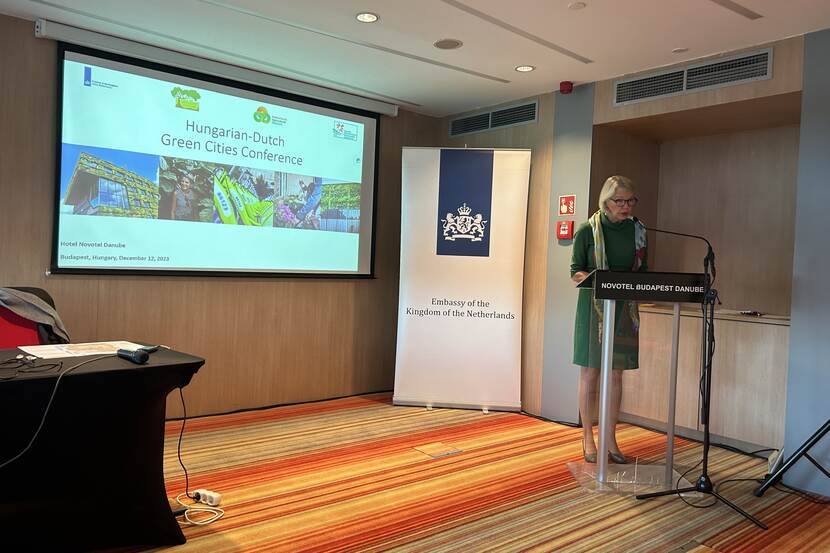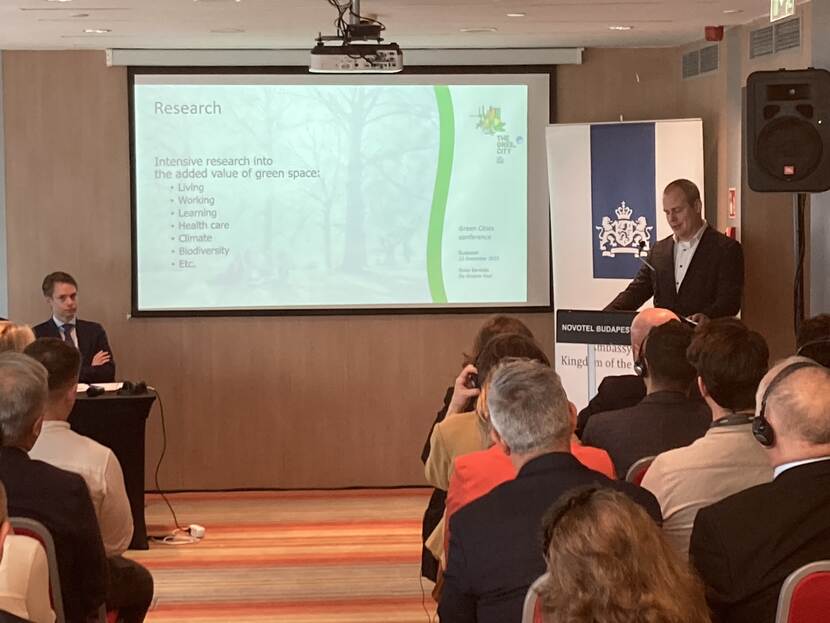Hungarian-Dutch Green Cities Conference: Sharing ideas and practices
Hungarian and Dutch stakeholders met in Budapest to share their experience, their best practices and visions for the future in urban greening.

On Tuesday, December 12, a Hungarian-Dutch Green Cities Conference brought together municipal and company representatives, experts, and other stakeholders for a knowledge-sharing event about past experiences and future plans in urban greening in Hungary and the Netherlands. The conference was co-organized by the Netherlands Embassy in Hungary and the Hungarian Ornamental Horticulturalist Association, with help from Green Cities Hungary.
In her opening remarks, Ambassador of the Netherlands to Hungary H. E. Désirée Bonis highlighted the fact that growing populations present a challenge to today’s cities. The Netherlands is one of the forerunners in the field of urban greening. Hungary is also making great steps in this area. Ambassador Bonis also remarked that, on invitation by the Netherlands Embassy in Hungary, representatives of eleven Hungarian cities visited the Floriade Expo in the Netherlands in 2022, which had city greening as its main theme. Dr. László Orlóci, President of the Hungarian Ornamental Horticulturalist Association told the audience about the achievements of urban greening in Hungary, and the importance of professional cooperation in his opening remarks.
In her keynote speech, Dr. Kisvarga Szilvia of the Hungarian University of Agriculture and Life Sciences talked about the role of Hungarian cities in mitigating the impact of climate change. The concept of green space criteria in city planning in Hungary goes back to 1920. Today, there are modern challenges with the abundance of covered areas in cities, and a low percentage of green area per urban resident, among others. However, there are future-oriented initiatives, like urban afforestation, the inclusion of environmental goals in construction legislation, hiring new green professionals in public service, and developing green infrastructure networks.

In his keynote speech, Sytse Berends from De Groene Stad explained how urban greening has come a long way in the Netherlands in the past twenty years, having to (and succeeding in) prove that “green is more than just beautiful.” Urban greening in the Netherlands has shown that it can improve, among others, citizens’ mental health, the property value of real estate, while it lessened the negative impacts of global warming on cities. City greening is also crucial in combatting other issues, like the decline of air quality and biodiversity, as well as improving water retention during droughts, and actually decreasing healthcare costs. Planting and greening has also proven to be a smart investment for the future, paying more and more dividends after years and decades.
From the Dutch side, representatives from the companies Greenmax, Niek Roozen, Nophadrain, OKRA and Sempergreen presented cutting-edge Dutch solutions for increasing green spaces in cities, vertical and rooftop gardening, improving the health of city trees and restoring biodiversity in urban green spaces.
From the Hungarian side, representatives from the cities Budapest, Debrecen, Miskolc, Pécs, Veszprém and Tata shared their experience in increasing the green coverage of dense urban areas, creating new green spots, utilizing nature-based solutions for plant health in cities, bee pastures, and transforming the vision and outlook of urban communities in line with the principles of the Green Cities movement.
The conference has attracted a diverse audience, including representatives of other Hungarian cities, including district municipalities from Budapest, researchers from universities like the Hungarian University of Agriculture and Life Sciences and the Van Hall Larenstein University of Applied Sciences, and participants from other companies including Van den Berk Boomkwekerijen, Agro-NL consult solutions, JUB Holland, Loos van Vliet BV, and Hungarian landscaping and design companies.
Urban greening is both a challenge and an opportunity for cities in Europe today. Hungarian and Dutch stakeholders often approach similar issues from different backgrounds – These include, among others, climate change, population growth, biodiversity loss, the urban heat island phenomenon, local supply chain vulnerabilities, and the needs and issues of local communities. The participants shared valuable insight on unique approaches which can inspire city planners, companies, municipalities and researchers alike in the future, and the event can be a stepping stone towards mutually fruitful future cooperation.